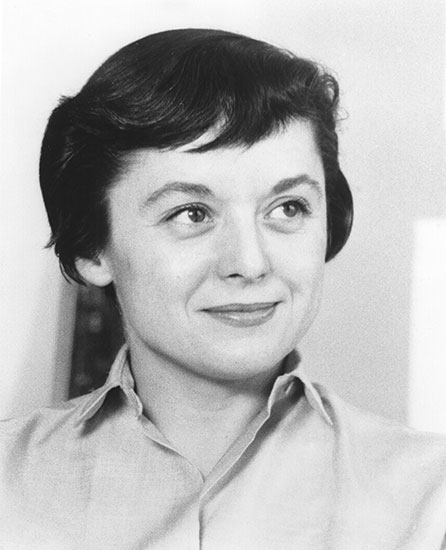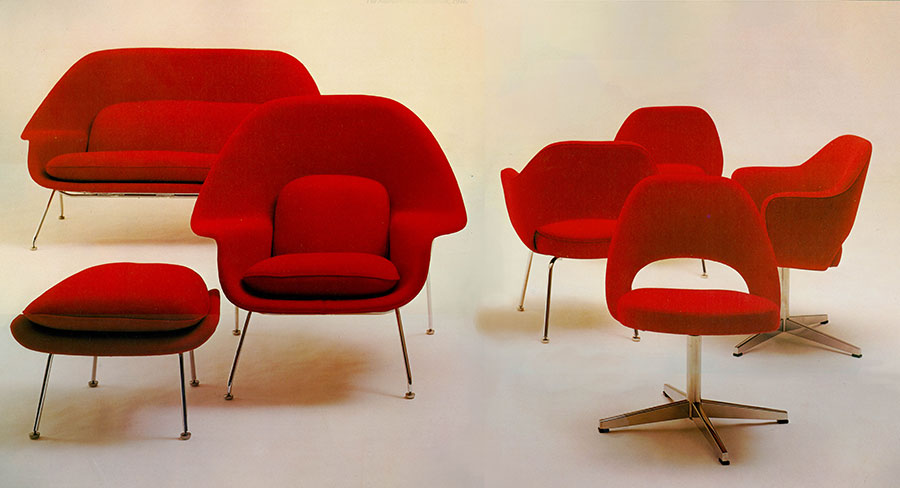Obituary: Florence Knoll Bassett, 1917-2019

Florence Knoll Bassett
Photo courtesy Knoll

Florence Knoll Bassett and her husband Hans Knoll
Photo courtesy Knoll

Florence Knoll Bassett and architect Eero Saarinen
Photo courtesy Knoll

The Eero Saarinen collection from Knoll, designed in 1948
Photo courtesy Knoll

The Florence Knoll table desk, designed in 1961
Photo courtesy Knoll

RECORD's November 1948 issue features Knoll's womb chair, which was designed by Eero Saarinen, on the cover.
Image © Architectural Record






''Everything I did was based on my architectural training,'' said Florence Knoll Bassett, who died last week at 101, in a 1983 interview with the New York Times. Best known for her work as a furniture designer, she was also an architect who studied with some of most important architects of the 20th century, and an entrepreneur who helped architects expand their practices into furniture design, greatly extending the reach of modernism.
In 1964, a year before she left Knoll to live quietly in Florida, theTimes called her “the single most powerful figure in the field of modern design.”
Orphaned at an early age, but already interested in architecture and design, Florence Schust attended Kingswood, the girls’ school at the Cranbrook Educational Community, in Bloomfield Hills, Michigan, and later the Cranbrook Academy of Art. The academy’s president, Eliel Saarinen, and his wife, Loja, practically adopted her; she spent summers with the Saarinen family at their home in Finland. One summer, she recalled, the Saarinens’ son, Eero, seven years her senior, “decided to give me a course in architectural history,” illustrating his impromptu lectures with sketches of Greek and Roman buildings.
From Cranbrook, she went to study at the Architectural Association in London. In 1939, as war descended on Europe, she moved to Cambridge, Mass., where she worked for Walter Gropius and Marcel Breuer. In 1941 she enrolled at Chicago’s Armour Institute (later the Illinois Institute of Technology), where she studied under Mies van der Rohe. Mies, she said, had a profound effect on the clarity of her later work. Moving to New York, she took a job with Harrison and Abramovitz. “Being a woman, I was given interiors,'' she told the Times.
After meeting Hans Knoll (whom she married in 1946), she helped turn his small furniture company (redubbed Knoll Associates) into a powerhouse. She designed a number of tables, chairs and sofas that went on to become classics, and worked with well-known architects on pieces that came to define the 20th century corporate office. Early on, she commissioned Eero Saarinen to design “a chair that is like a basket full of pillows . . . something I can curl up in.” She and Saarinen persuaded a fiberglass boat builder in New Jersey to manufacture what became known as the Womb Chair. (An image of the Knoll showroom with that chair was featured on the cover of Architectural Record in November 1948.) A decade later, Saarinen, reportedly vowing to eliminate “the slum of legs” found under conventional tables and chairs, developed his pedestal collection, with its gently curved bases, for Knoll. (The chair in the collection is often called the Tulip.) And Knoll persuaded her former teacher Mies to give her the rights to produce his Barcelona chair (designed with Lilly Reich in 1929). She was one of Mies’s most important proteges and exponents.
Florence’s project—carried on alone after Hans died in a car accident 1955—was about more than isolated objects. She often said that she designed furniture not for its own sake but to make modern interiors possible. It was thanks to her, the Times said, that “ modern architecture in the United States started to become a furnished reality.”
Indeed, at the same time she was designing furniture, she was running the firm’s Planning Unit, which was responsible for hundreds of interiors. Among the best-known were the offices she designed for CBS founder William Paley, and 1,000 or so of his employees, in the office tower known as Black Rock (1965) designed by Saarinen before his death in 1961.
Knoll was renowned for her presentation method, which involved the (then novel) idea of gluing swatches of real fabric and images of wood and stone at scale onto her plans and elevations. As she explained to her friend, the design writer Paul Makovsky for a 2017 article, samples of materials like teak, silk, wool and leather was “something an executive could identify with, especially if he was hesitant about embracing a Modernist aesthetic.”
While completing the CBS offices, she moved to Florida to be with her second husband, banker Harry Hood Bassett. It was there that the Times interviewed her in 1964 for an article that, typically for the era, devoted several column-inches to her looks. Among other observations: “Her hands, with their short, unpainted nails, are the used hands of a busy, creative person, but the enormous emerald solitaire looks perfectly at home guarding her wedding band.”
Did that trivialize Florence Knoll’s accomplishments? The same article, citing an unnamed authority, described her as “surely the most successful woman architect anywhere.” In fact, the owner of the enormous emerald solitaire may have done more to promote modernism than any other woman or man.









